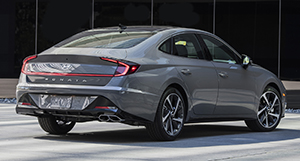2020 Hyundai Sonata & Sonata Hybrid
Yes, the midsize sedan segment is losing sales to SUVs. But, there are still a lot of 4-door sales to be had. And the manufacturers who value the segment are fighting harder than ever for buyers. By delivering more for less, what made sedans popular in the first place. And that’s where this all-new Hyundai Sonata enters our picture.
For years now, when it comes to the midsize sedans, it’s mostly a race to see who’s going to come in a distant 3rd behind Toyota Camry and Honda Accord. But, the Hyundai Sonata has certainly been in that mix.
Now, with the Ford Fusion dropping out of the race, the time has never been better for the 2020 Hyundai Sonata to make a major move up.
 The most recent Sonata designs have attempted to stand out with dynamic styling, some better than others; and that trend surely continues here with the all-new 8th generation.
The most recent Sonata designs have attempted to stand out with dynamic styling, some better than others; and that trend surely continues here with the all-new 8th generation.
A more coupe-ish design and definitely more luxurious looking; highlighted by their new Digital Pulse Cascading grille, and character lines punctuated with chrome trim.
Most dimensions have increased, including wheelbase and overall length, but it sits more than an inch lower than before. Wheel sizes range from 16 to 18-inches.
And just for wow factor, the laser-etched daytime running lights that frame the headlights and blend into the hood, look like chrome trim until on.
Powertrain choices are updated. The naturally-aspirated 2.4-liter is replaced with a 191-horsepower 2.5-liter I4; while a 1.6-liter turbo-4 returns, but it’s an all-new one outputting 180-horsepower and 195 lb-ft. of torque.
Both get an 8-speed automatic transmission, with a push-button gear selector similar to the Palisade’s. And the Sonata remains front-drive only.
A Hybrid returns as well, still 2.0-liter I4-based but with slightly less engine horsepower. Still, the added electric motor almost makes up for it.
So, combined output is down 1-horsepower to 192, but fuel economy increases significantly.
Government Fuel Economy Ratings go from 39-City, 44-Highway, and 41-Combined, to the hybrid’s 45-City, 51-Highway, and 47-Combined. In which we averaged a great 48.6 miles-per-gallon of Regular. 
For a much better than average Energy Impact Score, burning just 7.0-barrels of oil annually, with 3.1-tons of CO2 emissions.
The hybrid also comes with a new solar panel roof that adds power to the battery. In operation, the hybrid has near seamless power transitions; though if things are quiet in the cabin, you will hear the engine kick on.
We had a chance to take both a Hybrid and a turbo-powered Limited to our test track. The Hybrid felt plenty powerful off the line, getting to 60 in 8.9-seconds. But then, it quickly settles into a more comfortable pace; accompanied by relaxed shifts from its 6-speed automatic. Engine noise is pronounced, but at least there’s not the constant droning of more typical CVT-equipped hybrids. The ¼-mile was 16.8-seconds at 85 miles-per-hour.
The 1.6–liter was a little better, but not as much as we expected; 7.6-seconds to 60 is about mid-pack for its class. The 8-speed automatic here was a little busier, but equally smooth; seeing us through the ¼-mile in 15.8–seconds at 90 miles-per-hour.
The Sonata wasn’t the first Hyundai to be available here in the U.S., quickly following the Excel; but until SUVs started to rule the world, it was their most important model. We first met the Sonata in 1989; loved its host of standard features and big price advantage, but declared its interior, with uncomfortable seats, cheap materials, and a disagreeable odor, really needing improvement.
 Well, Hyundai has clearly been hard at work. After testing some speedier but comfort-challenged vehicles at the track on the same day, hopping into the Sonata for the drive home was a dream. Comfort abounds, materials are great, the tech is easy to use, and it all looks fantastic; expensive, but not pretentious.
Well, Hyundai has clearly been hard at work. After testing some speedier but comfort-challenged vehicles at the track on the same day, hopping into the Sonata for the drive home was a dream. Comfort abounds, materials are great, the tech is easy to use, and it all looks fantastic; expensive, but not pretentious.
Plenty of screen space inside; a large 10-inch one atop the dash, and larger 12-inch one for the digital instrument cluster.
And the Sonata has even more tricks up its sleeve. Hyundai’s Digital Key lets you use your phone to lock and unlock it. Using the key fob and Remote Smart Parking Assist, you can also have the car pull itself in and out of tight parking spots.
Not even on sale for a year, updates for the 2021 include even more standard features, a 19-inch tire and wheel package, and a sportier N Line model.
Just like 1989, the Sonata has a clear pricing advantage over its competition, ranging from a base SE at $24,575, to top Limited trim for $34,825.
The Hybrid starts with a unique Blue model at $28,725, and then on to the same SEL and Limited trims.
The 2020 Hyundai Sonata’s beauty, comfort, and tech features set it apart from most of the midsize family sedan segment. That may not be quite enough to challenge Honda and Toyota for the top spots, but those brands would be wise to take note of what the Sonata has to offer.
Specifications
- Engine: 1.6L Turbo I4 | 2.0L I4 (Hybrid)
- Horsepower: 180 | 192
- Torque: 195 lb-ft.
- EPA: 39 City / 44 Highway / 41 Combined | 45 City / 51 Highway / 47 Combined
- Our Fuel Economy: 48.6 mpg
- 0-60 mph: 7.6 seconds | 8.9 seconds (Hybrid)
- 1/4 mile: 15.8s @ 90mph | 16.8s @ 85mph (Hybrid)





